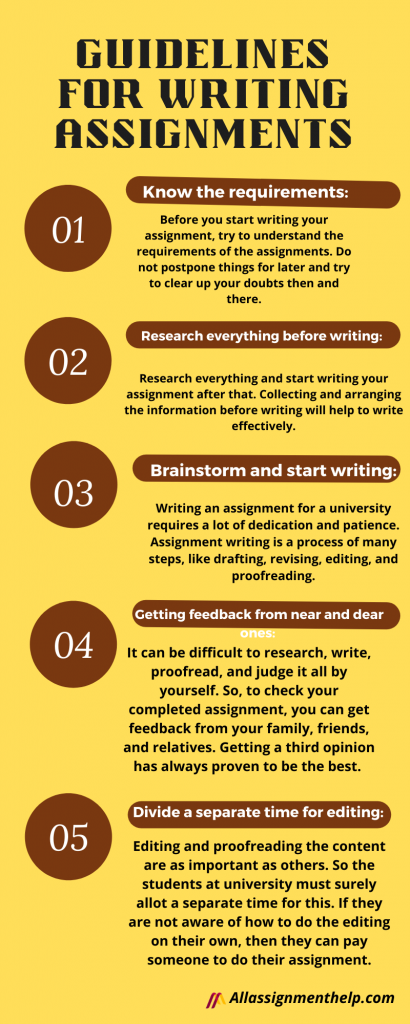Table of Contents
As high school and middle school students, we’ve all tackled numerous assignments. While we’ve completed a range of coursework, university assignments pose new and greater challenges. Each academic pursuit has its own unique assessments and exams. Understanding the various types of university assignments is crucial.
Don’t worry if you’re unfamiliar with them—experts at Allassignmenthelp.com have crafted this blog to address all your questions about university assignment writing. By reading this post, you’ll gain a comprehensive understanding of different assignment types and learn how to approach them effectively. Dive in to master the art of university-level assignment writing!
“Great ability develops and reveals itself increasingly with every new assignment.” -Baltasar Gracian
Also Read: Most Useful University Degree for the Walk of Your Life
Different Types of University Assignments
Throughout your academic journey, you’ll encounter various types of assignments. To tackle them effectively, it’s essential to understand the specific requirements and formats for each. Each assignment type is distinct, and adhering to the correct format is crucial for achieving higher grades. Lack of knowledge in this area can lead to difficulties and lower scores.
To avoid these pitfalls, I strongly recommend reading this blog post in its entirety. It will equip you with the necessary insights and strategies to excel in your assignments and enhance your academic performance.
Essay
Every student should be familiar with the essay as a type of assignment. We have all written essays at some point in our lives. We enjoy writing about our best friend, my pet, and a visit to Grandma’s house, among other topics. It is a type of essay in which you must respond to a question and present your argument by citing facts to back it up. Your classmates and the academic community are likely to be the primary audience for your essay. Argumentative, expository, narrative, and descriptive essays are the four types of essays. A three-part introduction, main body, and conclusion is the standard essay format. Each component is critical and requires equal knowledge and consideration.
Introduction:
The introduction is the first section of an essay. The way you write your introduction determines whether or not your reader will pay attention. As a result, the writer must be well prepared before beginning to write the introduction. The most important thing to remember when writing an introduction is to keep it short and sweet. The correct use of words in a sentence is critical.
Main body:
In an essay, the main body is an area where you can write all the necessary information. The main body consists of three short, big paragraphs. All these paragraphs work in a loop and are connected. The thoughts and words must be beautifully presented without making them look forced in the content.
Conclusion:
The conclusion is the last part of the essay. In this part, the students must include all the information in a summarised way. Including questions in the last part will encourage the reader to actively read your essay.
“Personal essay writing, dialectic discourse with the self, is a process of taking ideas and crushing them like grapes to create a homemade wine.” – Kilroy J. Oldster
Case study
The conclusion is the end part of the essay. Case study assignments are very common for medical and engineering students. The purpose of writing a case study is to investigate a situation, take a look at the positives as well as negatives of something, and recommend something based on the facts shown in the case study. An executive summary and table of contents must be included in the case studies. Your audience comprises professionals, politicians, and the general public. The case study structure must have a proper beginning, a worthwhile middle, and a perfect end.
Different types of case studies
- Collective Case Studies: As the name suggests, these involve studying a collective group of people or communities. This type of case study can be conducted by an individual or a group.
- Descriptive Case Studies: These case studies are based on descriptive theories. They compare pre-existing and current information to provide a detailed understanding of the subject.
- Explanatory Case Studies: Explanatory case studies involve causal investigations to explain real-life situations. They address basic questions such as what, why, and how, providing insights into specific phenomena.
- Exploratory Case Studies: These case studies offer a detailed and clear explanation of a case, allowing readers to gain a comprehensive understanding of the subject matter.
- Instrumental Case Studies: Used to gain deeper knowledge of a specific issue, instrumental case studies help observers understand more than just the surface-level phenomena.
- Intrinsic Case Studies: These case studies focus on the detailed history and present state of an issue or subject. For example, an intrinsic case study on a patient would provide in-depth information about the patient’s history, enabling readers to draw valuable conclusions.
Lab or practical report
A lab report or practical report is also an assignment that you have to do if you are a science, technology, mathematics, or engineering student. In this assignment, you have to explain what you have done in the lab practical and what your final opinion is on the topic. The title, abstract, introduction, method, results, discussion, conclusion, references, and appendices are the various sections of the lab report. You write it for fellow students and researchers thinking of doing the same practice.
Literature review
The literature review is arguably the most critical part of any assignment. It is a type of academic paper essential for students’ academic growth. In crafting a literature review, you must identify key concepts from the existing literature and evaluate contemporary perspectives on the topic.
This process involves using formal language appropriate for an audience of academics, researchers, and other scholars. The structure of a literature review typically includes an introduction, the main content, and a discussion of the findings. It is imperative to include correct citations and reliable sources to support your analysis.
The primary purpose of a literature review is to critically assess the data, research methods, and results presented in existing studies. This critical evaluation helps to highlight gaps in the research, question the validity of previous findings, and suggest areas for further investigation. By doing so, a literature review not only demonstrates your understanding of the subject but also contributes to the ongoing academic discourse.
What is the use of writing a literature review?
A literature review can act as a guide for students who are searching for something on the internet. If you want to compile an assignment but are not aware of how to start, then a literature review can be quite useful. It also keeps people up to date on current events in their respective fields. It also acts as a research paper, investing in comprehensive knowledge.
Annotated bibliography
What is an annotated bibliography?
An annotated bibliography is a task in which you have to find the most important items on a topic and have to assess how useful these items are about the topic. While writing an annotated bibliography, the students must write the sources in alphabetical order. Academicians, researchers, and other professionals will benefit from your annotated bibliography.
What can be included in this?
- You can include sources that you have searched.
- The investigating topic can also be included.
- Research methodology can be evaluated and included.
Reflective journal
A reflective journal is one of the types of assignments that you could be asked to write at the university level. Here, you have to realize what your understanding is and have to reflect on your thinking. With that, you have to show what and how you have learned something. You are your audience in the reflective journal.
These are the types of assignments you will encounter during your academic career. I hope you find it helpful and put it to use in your writing. If you’re having trouble writing these assignments, you can pay someone to do your homework and have them written by an academic. Those expert writers can provide you with high-quality assignment papers without charging you a fortune.
Also Read: How To Get Admission To Top University Overseas From India
Guidelines for Writing Assignments

Know the requirements:
Before you start writing your assignment, try to understand the requirements of the assignments. Do not postpone things for later and try to clear up your doubts then and there.
Research everything before writing:
Research everything and start writing your assignment after that. Collecting and arranging the information before writing will help to write effectively.
Brainstorm and start writing:
Writing an assignment for a university requires a lot of dedication and patience. Assignment writing is a process of many steps, like drafting, revising, editing, and proofreading. Being human, we cannot dedicate ourselves to all things at a time. For that, you can allot separate time for each and work accordingly.
Getting feedback from near and dear ones:
It can be difficult to research, write, proofread, and judge it all by yourself. So, to check your completed assignment, you can get feedback from your family, friends, and relatives. Getting a third opinion has always proven to be the best.
Divide a separate time for editing:
Editing and proofreading the content are as important as others. So the students at university must surely allot a separate time for this. If they are not aware of how to do the editing on their own, then they can pay someone to do assignment. By seeking professional assistance, students can be confident that their assignments will be edited and proofread, resulting in higher grades.
Try to complete it within the deadline:
Some students follow each of the steps above but become drowsy at the end and fail to finish their assignments. To avoid this, students can keep a chart and adhere to it without fail. This will aid in their time management and stability.
I hope that the above-given guidelines will have helped you to write your assignments. Some students criticize themselves for what they have not done and never praise themselves for what they have done. Try never to be one of them. If you are unable to write well-to-do assignments, then always remember that no one is human and tends to make mistakes. Failure is the stepping stone to success, so learn from it and keep working again and again.
About Us
Wondering where to pay someone to do my assignment for me? Then end your search here. All Assignment Help is a well-known name among students for assignment writing and services. We have years of experience in this field and have helped thousands of students with their assignments, homework, dissertations, case studies, and reflective writing. Whether you need assistance during the day or night, our professional assignment writers are always ready to help you. On our website, we have qualified experts from different fields who have expertise in providing the highest quality of writing.
Frequently Asked Questions
| Question 1: What is a systematic literature review and how to write it? Answer 1: A systematic literature review is significantly more difficult than a standard literature review. Before you start writing, make sure you have a clear plan and protocol in place. Following that, a thorough review can aid in locating the repeated words and sentences. |
| Question 2: At a university, why do professors give assignments? Answer 2: The main purpose of giving assignments at universities is to enhance the knowledge and understanding of the students. By writing assignments, the students get the advantage of practicing and learning their subject in a better way. |
